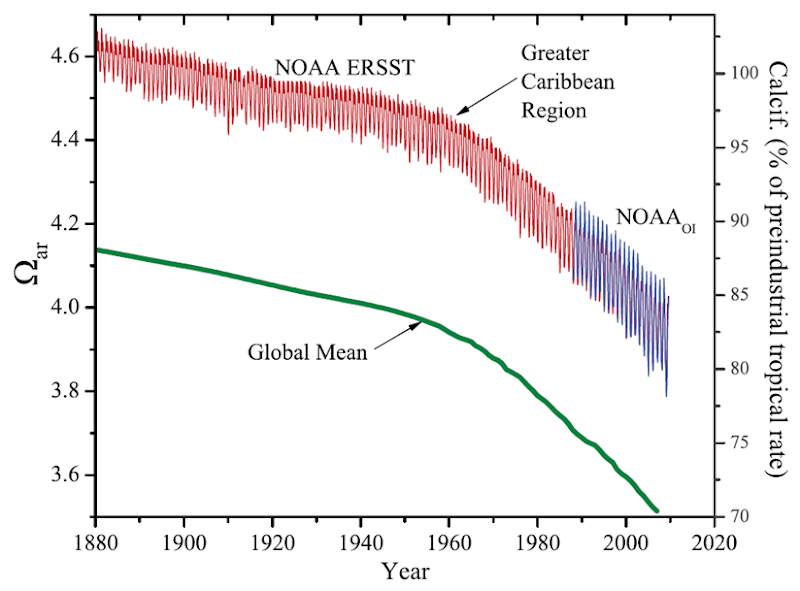Graph of the Day: Aragonite Saturation in the Greater Caribbean Region, 1880-2009
An extended time series of the regional mean aragonite saturation state for the Greater Caribbean Region derived using the NOAA extended reconstructed SST (ER SST V3b; red curve) with the Experimental Ocean Acidification Product Suite v0.3 values derived from satellite SST overlaid (blue curve). The global mean (green curve) is estimated from the representative SST (18°C) and AT (2320 μM kg-1) values. The left axis depicts the aragonite saturation state while the right axis is an estimate of decline in calcification rate relative to pre-industrial calcification in the Caribbean derived according to Langdon and Atkinson (2005). The secular decline in Ωar should have diminished regional calcification rates by nearly 20% relative to preindustrial values, assuming the first-order empirical relationship of Langdon and Atkinson (2005), where calcification rate (G, mmol CaCO3 m-2 h-1) = (8 ± 1)(Ωar – 1). It should be noted that coral sclerochronological studies have not yet revealed a decrease in calcification rate within the GCR, although evidence of recent decline has been reported for massive corals from the Great Barrier Reef (De’ath et al., 2009), but the source of this decline is not solely attributed to ocean acidification. Ocean acidification does not occur in isolation, and there are multiple factors that could mute the response in corals, including enhanced calcification as a consequence of warming. This benefit of temperature-enhanced calcification exists only at temperatures below those that lead to physiological stress. Beyond these temperatures, thermally induced bleaching can occur, resulting in mass bleaching events such as those that occurred across the region in 2005 (Figure 5; Wilkinson and Souter, 2008). Additionally, recent work showed that acidification and rising temperatures can act in concert, potentially increasing corals’ susceptibility to bleaching (Anthony et al., 2008; Crawley et al., 2009). This combination of acidification and warming is expected to continue with rising anthropogenic CO2 emissions, leading to a particularly damaging combination (Hoegh-Guldberg et al., 2007; Veron et al., 2009).
D.K. Gledhill, R. Wanninkhof, and C.M. Eakin, Observing Ocean Acidification from Space [pdf], Oceanography, Special Issue on the the Future of Ocean Biogeochemistry in a High-CO2 World, December 2009, Volume 22, Number 4
